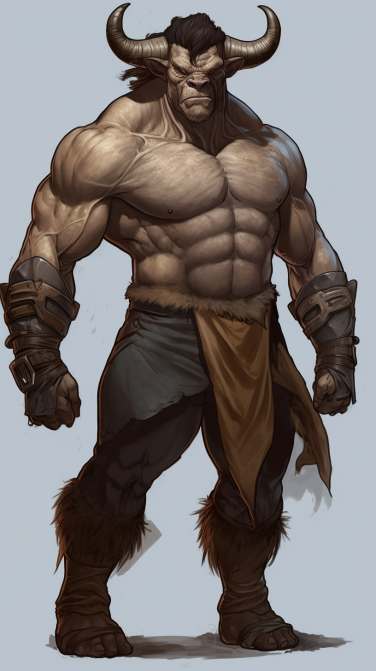Kyrfolk
The Kyrfolk are a bull-headed humanoid species that live in harmony with nature and follow a code of honor. They were created by the gods as guardians of the earth and have a strong connection to shamanism. They first settled along a river that flowed into the inner sea and developed a complex society with stone structures, writing, and mathematics. They also made pottery and painted rocks. They traded with other cultures and expanded their territory. They defended themselves from enemies with their horns, hooves, and weapons. They also befriended other races that shared their values.
The Kyrfolk reproduce sexually and have a gestation period of 10 months. They grow quickly until puberty, which starts at 15 years of age. They develop horns, facial hair, and breasts during puberty. They reach maturity at 20 years of age and live for about 100 years. They have good hearing and smell, but poor vision and color perception. They communicate with low-frequency sounds and perceive the natural world through their spirituality.
Basic Information
Anatomy
This species is a large, muscular humanoid with a bull-like head and horns. They have hooves instead of feet and fur covering their bodies. Their fur can be various colors, such as black, gray, white, red, brown or tan. They stand between 2.1m and 3.6m tall and weigh between 180kg and 450kg.
Genetics and Reproduction
The gestation period lasts for about 10 months, after which the female gives birth to a single calf or rarely twins. The calf is nursed by its mother for about a year, and reaches sexual maturity at around 15 years of age.
Growth Rate & Stages
This species grows quickly in its early years, reaching about half of its adult height and weight by age 5. It then slows down its growth until puberty, which starts around age 15 for both males and females. During puberty, the species undergoes a growth spurt and develops secondary sexual characteristics, such as horns, facial hair, and breasts. Puberty lasts for about 5 years, after which the species reaches its full physical maturity. The average lifespan of this species is around 100 years, but some individuals can live longer.
Ecology and Habitats
Their first primitive settlements were along one of the major rivers, usually roaming the region between the forest and the river and along a small part of the coastal region of the freshwater ocean of the inner sea.
Dietary Needs and Habits
This species is omnivorous, meaning it can eat both plants and animals. However, it prefers a diet rich in grains, fruits, vegetables, and herbs that grow on the plains. It also hunts or scavenges for meat, such as buffalo, deer, or fish. It uses its horns and hooves to defend itself from predators and competitors. It stores its food in leather pouches or baskets that it carries with it or hides in safe places. It also shares its food with its tribe members and respects the spirits of the animals it kills.
Biological Cycle
This species originated from the riverine regions, where they established their earliest settlements along the banks of a major river. They adapted to a nomadic lifestyle, roaming between the forest and the river, as well as the coast of the freshwater ocean that forms the inner sea.
Behaviour
This species is generally calm and peaceful, valuing harmony and balance among its members and with nature. It has a strong sense of honor and loyalty, and follows a code of conduct based on respect and wisdom. It is also courageous and compassionate, willing to defend its tribe and allies from any threat. It has a deep spiritual connection to the earth and the elements, and reveres its ancestors and elders. It is wary of outsiders, but can form friendships with other races that share its values.
Additional Information
Perception and Sensory Capabilities
This species has well-developed senses of hearing and smell, which help them to detect predators and prey on the plains. They can also communicate with each other using low-frequency sounds that travel long distances. Their vision is adapted to low-light conditions, but they have difficulty seeing fine details and colors.
Civilization and Culture
History
The Kyrfolk were created by the gods as guardians of the earth. They were given a strong connection to nature and shamanism and a sense of honor and loyalty. They first settled along [a major] river that flowed into the freshwater ocean of the "Inner Sea". They adapted to a riverine lifestyle, building circular pit houses and cultivating corn, beans, and squash. They also hunted and fished for meat, and traded with other cultures along the coast. They developed a complex society with social classes, religious ceremonies, and artistic expressions. Their culture build monumental stone structures, developed a system of writing and mathematics, and studied the crystal domes structure. They also lived in semi-subterranean houses, made distinctive pottery, and painted symbols on rocks. Their architectural styles, ceramic designs, and artistic motifs were great sources of trade. They expanded their territory and established several branches across the region.
Scientific Name
Homo Taurus Sapiens
Geographic Distribution
Remove these ads. Join the Worldbuilders Guild











Comments